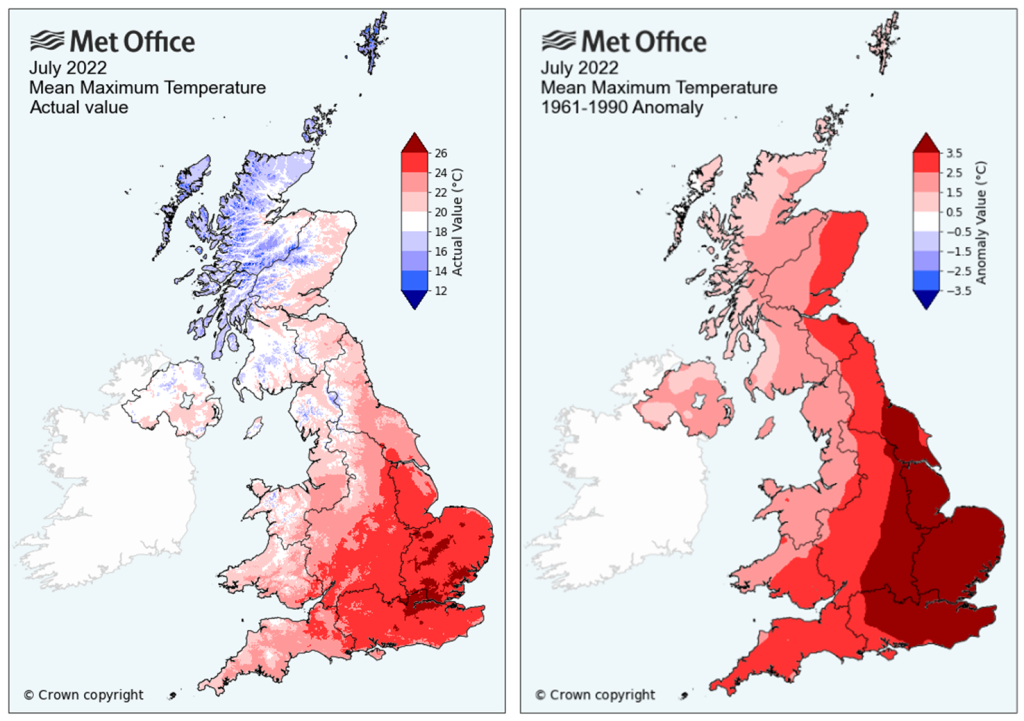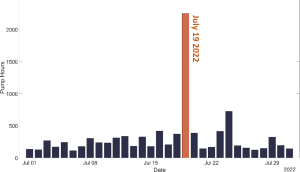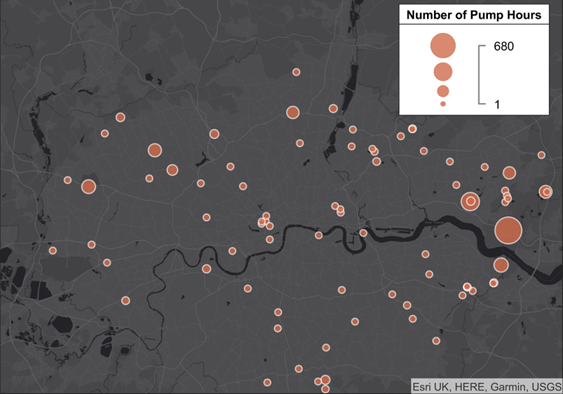How WUI fire risk-reduction applies to dense urban areas
Written by Simona Dossi, Shrey Bohra, and Guillermo Rein
On July 19th 2022 the London Fire Brigade experienced its busiest day since World War II assisting many incidents, including several wildfires which spread to buildings. In total 41 London properties, including houses and shops, were destroyed by fires.
In July 2022, the UK reached record high temperatures. The heat wave caused a number of wildfires throughout the country: Two major incidents due to fires were declared on July 19th in Lincolnshire and Yorkshire, and a third on July 22nd in Surrey due to a large wildfire of around 8 hectares. Summer 2022 brought record high temperatures Europe, where extreme conditions contributed to numerous intense wildfires in Spain, Portugal, France, Italy, Greece, and northern Morocco.
Wildfire ignition of urban areas is a pressing concern, causing extensive damage in residential areas near the wildlands worldwide. The significant impact of the July 19th wildfires on London residents and their properties shows the fire damage risk of large and dense urban areas. The large population, high number of economic activities, buildings, parks, gardens, and vehicles densely packed in a large urban area, all contribute to a high fire ignition and damage potential. Here we consider the July 19th fires in London and what wildfire and WUI fire risk reduction strategies could be considered to reduce future fire impact.
July 2022 Climate
All-time high temperatures (40.3 °C in Lincolnshire) were recorded on July 19th. The UK climate in July was marked by high temperatures and dry conditions, especially in south-eastern regions. The south-east regions were driest, reaching below 25% of the average rainfall. The Met Office recognised climate change as a primary cause of the drier and hotter climatic conditions.

Figure 1: Map of UK mean maximum temperatures (left) on July 2022, and the maximum temperature anomaly value between 19961-1990 and July 2022 (right). Source: Met Office
July 19 London Fires
London’s current population is over 9,540,000 people. The City of London is 2.9 square km large, and Greater London area is greater, about 1,569 square km. The city also has 3,000 parks of varying sizes with varied vegetation, many trees, parks, shrubs, all located near streets, squares, private gardens, and balconies. This urban layout, combined with high social and industrial activity can result in fire ignitions and fast fire spread.
The fire brigade received over 1146 calls and recorded over 100 fire incidents on July 19th. Sixteen firefighters were injured and a major incident was declared to assist the higher need for emergency responses resources. Wildfires spread to nearby buildings in Wennington, Dagenham and Kenton, different areas in Greater London. In total, 41 properties were destroyed; fire damaged garages, vehicles, outbuildings, a car wash and a town hall.
The number of pump hours relate to the amount of water used to suppress and contain the fires, and therefore to the fires size and intensity. Figures 2 and 3 are graphs showing the number of pump hours recorded by the London Fire Brigade used to contain fires in London. Figure 2 compares the hours used on July 19th to the remaining July 2022 days (Figure 2), and to the ten days requiring the highest number of pump hours between January 2019 and July 2022 (Figure 3). It is clear that on July 19th in London experienced a significantly higher fires size and intensity, compared to the expected trends. July 19th required over a 50% increase in pump hours from the second most intense day for fires in London in over 2 years.

Figure 2: Number of water pump hours required to contain fires in London every day of July 2022, London Fire Brigade data. The amount of water required to contain fires is related to the size and intensity of the fires.

Figure 3: London Fire Brigade days requiring highest number of pump hours to contain fires between January 2019 – July 2022. July 19th 2022 is has highest recorded pump hours
One of the fires occurred in Wennington, east London, on the Green garden and lasted over 8 hrs. Around 40 ha of wildland, farm buildings, houses and garages were affected. Nearly 90 properties were evacuated, and 6 houses, 2 outbuildings, 6 garages, 12 stables and 5 cars were destroyed. Fire crews from six surrounding fire stations, 15 fire engines and around 100 firefighters, assisted the fire. Residents described that the ignition occurred in a compost heap in the garden, which started smoking, started exhibiting flames as fire grew, and finally spread to neighbouring buildings and structures.
The definition of a major incident is an event with consequences which require emergency responders (the NHS, local authorities, firefighters) to implement special arrangements. The high demand on both the fire service and ambulances on July 19th was also caused by the several simultaneous fires. The London Fire Brigade responds to diverse incidents caused by various hazards, and as extreme weather (heatwaves, strong winds, storms, floods) become more common, so can the high demand on the fire service. Wildfire risk reduction and adaptation lessons can increase overall preparedness in the changing climate.
Wildfire Risk Reduction
Specific wildland-urban interface fire risk reduction measures can be applied to London.
1.- Building spacing and construction
Wildfire research has investigated safety separation distances between buildings and burning combustible materials, which include vegetation, wooden structures, vehicles. These distances can especially protect against flame heat and radiation exposure as well as limit fire spread and damage after ignition. Firebrands, small burning particles carried in the wind are more complex wildfire threat to mitigate and discussed in more detail in a previous article. Many buildings in London are built with bricks, concrete, asphalt roofing, and composite materials. Although some of these materials are fire resistant, nearby burning vegetation would expose them to flames and heat which can enter through weaker parts of the building external structure. Furthermore, London has a large and diverse population. More socially and financially vulnerable areas are more likely to have less well maintained and constructed buildings, which contributes to higher fire damage and impact vulnerability.
The amount and maintenance of flammable material on and around buildings is a key factor in determining the building’s fire risk. Enforcing separation distances and regular maintenance of buildings external envelope can reduce the risk of fire ignition and spread. Both general information for residents and scientific comprehensive methodologies on separation distances are available. Regulating the use of materials for building exterior constructions, installing mesh screens on vents, and closing all openings can further protect buildings from fire ignitions. Focusing on higher fire risk areas, including more densely built neighbourhoods, buildings closer to vegetations, and more vulnerable populations, is important to reduce fire occurrence and damage.
2.- Vegetation reduction and maintenance
Numerous factors influence the fire risk extent of green vegetated areas, e.g. parks or gardens, near buildings. The vegetation amount, layout, plant species and watering condition are all important contributing aspects. Reducing vegetation continuity, especially of dry vegetation which can easily spread flames in case of ignition, is a widely accepted and applicable wildfire risk reducing measure. Wildlands surrounding the city can be maintained to reduce fire potential and spread speed. Creating fire breaks and maintaining separation distances between residential streets and green areas, especially with high amounts of dry vegetation, can reduce the spread in case of fire. Safe separation distances and amount reduction can apply to all flammable fuels in parks, streets and gardens: e.g.: garbage, sheds, wooden tables, benches.

Figure 4: Map of large fires in London on July 19th 2022.
3.- Community preparedness: uniting residents, emergency services, and industries
The UK fire service, additionally to responding to emergencies, also works in prevention. After identifying communities, sites, and practices at higher fire risk, targeted messages are provided to mitigate the risk. This important practice can be enhanced through further resources and community events. As wildfire risk is increasing globally due to climate change and land-use changes, the integration of wildfire preparedness measures in communities is increasingly necessary and important. Community-tailored resources and activities are already available in many wildfire-affected communities. By including and empowering residents to participate in fire risk reduction, communities are more likely to succeed in preventing and responding to fire events. The London Fire Brigade, as other urban fire services, may require additional wildfire training and procedures in communication practices to successfully respond and continue preparing communities from evolving fire risks.
Conclusion
Due to the high risk to life, property, and green spaces in cities like London, it is important to apply wildfire risk reduction measures to urban planning. Enforcing safety maintenance checks and separation distances within neighbourhoods and green areas can help reduce fire spread. Regulations considering the increasing risk due to rising temperature, flammable material accumulation, and densely packed green and living areas, can set higher standards for building construction materials, maintenance, and evacuation. Lastly, communicating fire risk and mitigation measures to residents can inspire community preparedness and prevention.


Leave a Reply